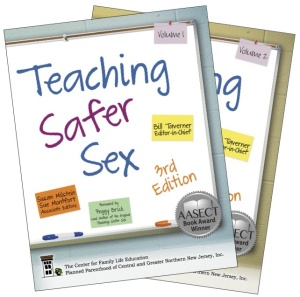
Coming off of yesterday’s post encouraging participants to talk about safer sex in general, today’s lesson plan from Teaching Safer Sex is about condoms and considering the reasons people don’t talk about them, the cultural stigma around them, and how to bring them up and talk about them anyway.
CONDOM TALK
Practice Makes Perfect
By Louise Yohalem
Objectives
By the end of this lesson, participants will be able to:
- Identify feelings people have about using condoms.
- Describe ways that help a person become more comfortable talking about condom use with a partner.
- Apply negotiating skills for condom use.
- Describe how condoms can be a positive component of safer sex.
Rationale
There are numerous reasons why people do not use condoms: they may be unfamiliar with them; be embarrassed to talk with a partner about using them; or believe negative myths that convince them not to use condoms. This activity gives participants a chance to confront possible barriers to condom use and to respond to these barriers. After participants have had a chance to develop condom dialogue competence, they get to practice their skills and increase their condom efficacy. Finally, negative ideas about condoms are confronted by giving participants a chance to brainstorm all positive reasons to use them.
This is a short, straightforward lesson that involves creating dialogue in a way that will be concretely useful to participants in conversations about condom usage. It utilizes some of my favorite things:
- Markers
- Flip charts
- Brainstorming real language
This kind of activity is real – and participants get that and appreciate it. There’s nothing worse than being thrown into a conversation where someone is telling you that they love you and don’t want to use a condom – and if you love them you won’t want to use a condom either – and not having any idea what that means. The push and pull of the emotional manipulation that underpins examples like this generally need to be explicitly stated for young people to understand why they feel pulled and hurt and give into emotional demands.
It also serves to explain to participants who might be inclined to really feel that way – and so manipulate their partners – why it’s not acceptable for them to do that.




